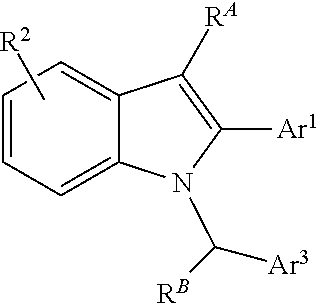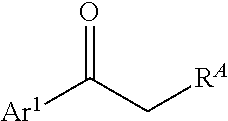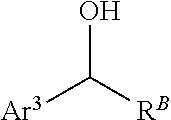Processes and intermediates for preparing indole pharmaceuticals
a technology of indole and pharmaceuticals, which is applied in the direction of physical/chemical process catalysts, metal/metal-oxide/metal-hydroxide catalysts, organic chemistry, etc., can solve the problems of yield loss and high cost of current and conventional processes, and achieves low cost, improved overall purity, and high efficiency
- Summary
- Abstract
- Description
- Claims
- Application Information
AI Technical Summary
Benefits of technology
Problems solved by technology
Method used
Image
Examples
examples
Example
[0199]Products are analyzed by LCMS (dissolving the product in acetonitrile) under the following conditions: Column: Agilent Eclipse XDB-C18, 5 uM, 4.6×150 mm, Solvent A: 5 mM Ammonium acetate in Water, Solvent B: 5 mM Ammonium acetate in CH3CN:MeOH (1:1), Time 0 min: 20% B, Time 10 min: 100% B, Duration of run: 15 min, Gradient elution flow rate: 1.00 ml / min.
Example
[0200]1-(4-Benzyloxy)phenyl-2-(1-(4-(benzyloxy)phenyl)-propylidenehydrazine (4). 4-(Benzyloxy)phenylhydrazine hydrochloride (2) is obtained as described by Bravo-Altamirant et al., in ACS Med. Chem. Lett., 2:154-159 (2011), the disclosure of which is incorporated herein by reference. Compound 2 (7.9 g, 31.6 mmol) (finely ground), 4-benzyloxypropiophenone (3) (6 g, 25 mmol) and ethanol (200 mL) are added to a 1 L round bottom flask with football stirring bar and reflux condenser with an argon inlet valve on top. A solution of NaHCO3 (1.9 g, 22.5 mmol) in water (35 mL) is added and the reaction mixture is heated to ...
example
[0204]Bazedoxifene acetate (9A). See, generally, Miller et al., in J. Med. Chem. 2001, 44, 1654-1657. 1-(4-(2-(Azepan-1-yl)ethoxy)benzyl)-5-(benzyloxy)-2-(4-benzyloxy)phenyl)-3-methyl-1H-indole (8A) (2.0 g, 3.07 mmol) is dissolved in tetrahydrofuran (100 mL) in a 500 mL round bottom flask with a stirring bar and sodium ascorbate (100 mg) is added followed by ethanol (100 mL). The flask is blanketed with argon, 10% Pd / C (200 mg) is added and the flask is covered with a rubber septum. The reaction mixture is blanketed with hydrogen (balloon) and stirred for 15 h at ambient temperature. TLC (CH2Cl2:MeOH 9:1) shows the disappearance of 8A, Rf˜0.6 and a single new spot (Rf˜0.1, LCMS retention time 8.6 min, m / e 471). The hydrogenation reaction is filtered through a Celite pad, washed with ethanol (25 mL) and the filtrate is evaporated to a colorless oil. The oil is dissolved in acetone (30 mL) and heated to 35° C. with stirring. Seed crystals of bazedoxifene acetate (9) are added to the s...
PUM
| Property | Measurement | Unit |
|---|---|---|
| flow rate | aaaaa | aaaaa |
| retention time | aaaaa | aaaaa |
| retention time | aaaaa | aaaaa |
Abstract
Description
Claims
Application Information
 Login to View More
Login to View More - R&D
- Intellectual Property
- Life Sciences
- Materials
- Tech Scout
- Unparalleled Data Quality
- Higher Quality Content
- 60% Fewer Hallucinations
Browse by: Latest US Patents, China's latest patents, Technical Efficacy Thesaurus, Application Domain, Technology Topic, Popular Technical Reports.
© 2025 PatSnap. All rights reserved.Legal|Privacy policy|Modern Slavery Act Transparency Statement|Sitemap|About US| Contact US: help@patsnap.com



